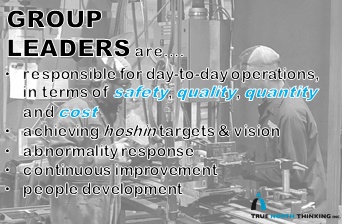Essential Knowledge for Supervisors – Part One
Oct 26, 2015 | Posted by Matt Elson

Essential Knowledge for Supervisors – Part One
There are certain things that a supervisor (also known as a group leader, superintendent, etc.) should know and practice to enable them to function as effectively as possible at the gemba. The gemba can mean the shop floor, hospital medical ward or call center floor…wherever the action takes place and the value is added for the customer.
This is a brief outline of a few of these basics.
Understanding Operations (Management):

1. Practical Experience is Valued Over Theoretical Knowledge
- You can’t “manage” or lead from behind a desk, using reports. You must go & see yourself to gain a full understanding of what is actually happening,
- Rely on facts, not common sense and conjecture.
2. Visual Control
- Everybody should be aware of the current operations situation…are we in an abnormal or normal situation?
- Information should be easily accessible (not “trapped” in a tracking system) and easily recognizable.
3. Normal and Abnormal
- A set of standards is needed for everyone to know whether a given situation is normal or abnormal…this is called pre-specification. Standards should be clear and accurate.
- Who takes what action and when during an abnormal situation is part of these standards.
Kaizen at the Gemba (Improvement)

1. Maintenance and Kaizen
- “Maintenance” is preserving the current situation (this doesn’t mean doing nothing!). “Kaizen” means to improve beyond the current situation towards true north.
- “Maintenance” is not easier or simpler than “Kaizen”…it is very difficult to maintain the current standards.
- “Kaizen” is most effective when we it is a series of daily efforts to make our current situation better.
2. Kaizen, Kaizen, Kaizen
- “Kaizen” is never over; it is today’s improvement, tomorrows current situation and tomorrow’s regression.
- A supervisors roles is to maintain forward momentum towards true north at all times, even when faced with difficult challenges.
3. Kaizen Priority
- Think in terms of two broad categories: Human centered improvement and material /machine improvements.
- Since people are the corner stone of everything, kaizen focus is first on human centered improvements, then on materials or machine improvements.
4. Improving the Ability to See Problems
- Watching processes and situations without purpose is a waste of time (see “Management By Walking Around, MBWA“). Practising your observation skills (by using some of the approaches in TPS) allow you to always challenge the status quo or push towards a better way. Always question: “Can this be done an easier way?”
- Looks at things from various angles, including Human, Technical, Management and Philosophical perspectives.
- Leadership needs to set a positive example for people by taking the initiative to make things better. Trust is earned through action, not through words or orders.
5. Don’t Be Afraid to Make Mistakes
- Someone who can’t make decisions due to fear of mistakes is not a leader.
- Supervisors should be practitioners of scientific thinking, and not critics. Ideas are possibilities for improvement and learning, so should be put into practice after testing to see if they work.
- Problem solving doesn’t always work well the first time; this is natural. Don’t be afraid to try things out a few times.
- It is also equally important to recognize and own failure. This is not a weakness, as long as you analyze the causes of the failure and learn from them.
If you liked this article, watch for Part Two and Part Three of this series on Essential Knowledge for Supervisors and let me know what you think! Write a comment below on your experiences (positive or negative) in your roles as a supervisor.
Matt Elson is a student of continuous improvement, leadership and strategy. He works with the rest of the team at True North Thinking Inc., helping businesses and organizations reach their goals. Changing the world. One kaizen at a time.
You can join the conversation by following True North Thinking Inc. on LinkedIn here: http://linkd.in/1kGLA5x and by signing up for the newsletter, The Journey to True North, here (top of the page): http://bit.ly/1lQM2vn
This article also appears in Matt’s LinkedIn Blog, here.
Learn Four Strategies To Start Improving Any Area Of Your Business